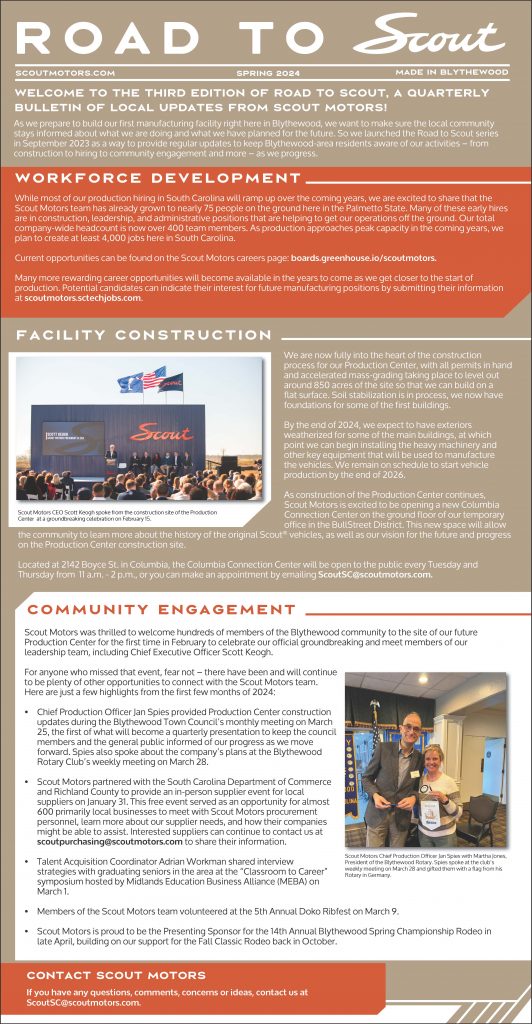JENKINSVILLE – A 30-page report, issued by the Nuclear Regulatory Commission (NRC) last week, classifies two findings associated with the accidental damage in February of the nuclear containment vessel under construction at the V.C. Summer Nuclear Station as “non-cited violations,” calling both findings “of very low safety significance.”
The report did, however, note a breakdown in communication between Chicago Bridge & Iron (CB&I) workers, field engineers and construction supervisors, as well as a lack of training and oversight, all of which contributed to the damage.
Between Feb. 5 and Feb. 10, a CB&I crew was removing several pieces of vertical rebar inside the containment vessel prior to pouring additional concrete inside the vessel. While doing so, workers inadvertently drilled into rebar within the existing concrete, damaging the metal bowl of the structure. The containment vessel houses the nuclear reactor.
CB&I did not report the damage to SCANA, which operates the site, until Feb. 16, the NRC said.
The damage, which the report states has been corrected, was the end result of a chain of events that began on Jan. 9. According to a time line laid out in the report, it was then that CB&I surveyors and carpenters marked out on layer two of the concrete floor of the containment vessel a line to be used as a reference point for locating three embedded plates. That line was off by one foot because several vertical rebar dowels protruding from the concrete interfered with the chalk line.
A second crew of carpenters, not realizing the center line was offset, later came in and marked what they thought were the locations of the plates.
On Jan. 20, CB&I field engineers identified that there were rebar dowels in the second layer of concrete that interfered with the planned installation of pipe in the yet to be poured third layer. This interference would require a new dowel hole to be bored. On Jan. 23, a field engineer identified that the rebar dowels interfered with the marked locations of the plates. Referencing a drawing showing the location of the dowels, the engineer identified the dowels as type 3A and 3G vertical dowels.
“This was an error,” the report states. “The correct drawing . . . shows that the interfering dowels were actually type 3B and 3L vertical dowels.”
The correct drawing also noted the actual location of the dowels, the report states.
A Westinghouse Electric Company (WEC) engineer provided repair instructions and engineering justification, but did not recognize that the plates were in locations that could not potentially interfere with type 3A and 3G dowels.
“A comparison of CV (containment vessel) drawings would have revealed the error,” the report states. “Had the responsible engineer correctly identified the locations of (the embedded plates), he would have realized that the interfering dowels were type 3B and 3L vertical dowels.”
The WEC engineer specified that the bore holes be a minimum of 25-inches deep, which could accommodate type 3A and 3G dowels, but not 3B or 3L dowels. The oversight also escaped the eyes of a second WEC engineer on Feb. 3, and a CB&I field engineer marked the spot for the new bore holes on layer two of the concrete, holes that corresponded with the erroneously marked embedded plates. Two days later, drilling began.
Carpenters discovered the mistake in the marking of the plate locations on Feb. 9 and laid out new center lines. A field engineer then marked three new holes to be drilled, while also determining that three of the previously drilled holes could not be used and required filling with grout and replacement dowels.
By Feb. 10, CB&I had 10 holes, seven of which were to have new dowels and three useless hoes that required grout and replacement dowels. When the 10 holes were filled with water for pre-soaking, one of the holes would not hold water. Two days later, an investigation was under way to determine why the hole designated as R1 would not hold water. Borescope photographs revealed that the containment vessel had been exposed during the drilling.
Sections of nine concrete cores from the drilling were recovered from a dumpster and it was discovered that structural rebar had been cut in at least two sections of the cores.
Among the report’s findings were a lack of supervision (“Field engineers made key decisions without input from their supervisors.”); a communication breakdown (“Field engineers failed to communicate problems with the core-drilling activities . . . to their supervisors”); and problems with work management (” . . .oversight was not provided to avoid errors. . . . work instructions did not contain adequate precautions to avoid damaging these components.”).
The report also noted training issues (“Neither craft nor field engineering personnel received training at the site on core drilling operations, and they were not knowledgeable of the appropriate procedures governing core drilling.”); a failure to “challenge the unknown” (“Field engineers did not stop core drilling when structural rebar was encountered.”); and a failure to adequately plan (“Craft personnel held pre-job briefs prior to core drilling, but the briefs only included industrial hazards and personnel safety issues. Craft personnel did not discuss potential adverse impacts on structures, systems or components. Field engineers did not attend the pre-job brief with craft personnel.”).
According to the report, the failure to implement procedures for coring concrete and post installing anchors was a “performance deficiency” that was “more than minor.” Coring was not stopped when rebar was contacted, the report states, and neither the field engineer nor the construction superintendent contacted the engineer for approval or to report the nonconformance of the impacted rebar, as required by procedures. Prior to grout placement on two core locations, neither the field engineer nor the construction superintendent verified the rebar was not cut.
The report also classified as a ‘more than minor performance deficiency’ the failure to verify that a design change did not adversely impact the containment vessel. “Had it been recognized that the interfering dowels were actually 3B and 3L type dowels,” the report states, “then the potential for impacting the CVBH (containment vessel bottom head) would have been more apparent.”










